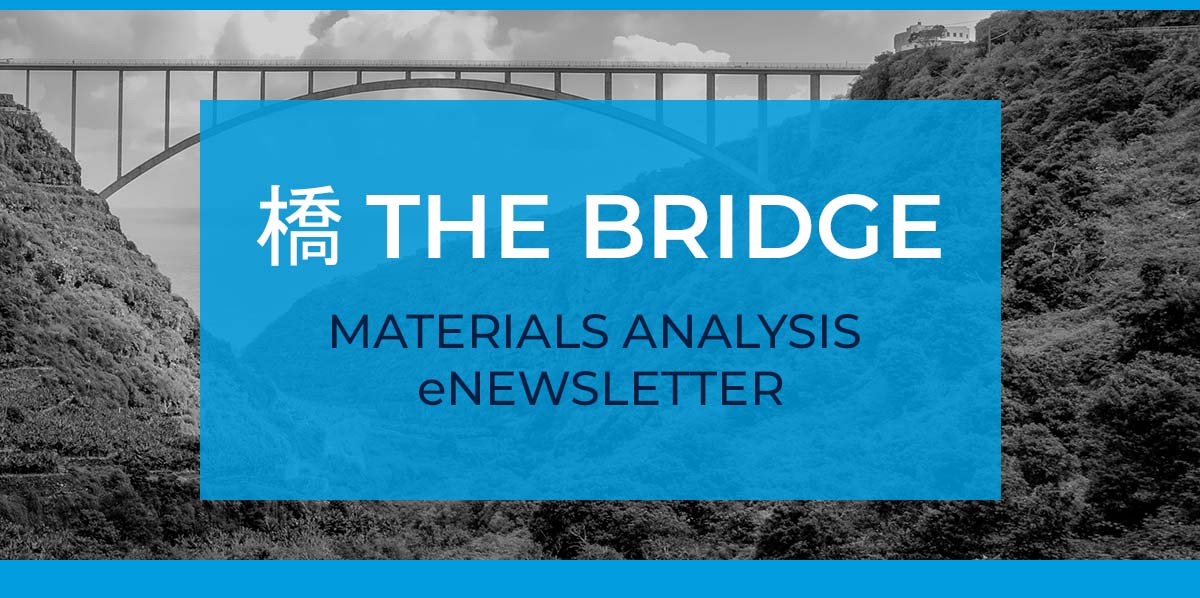 March 2024, Issue 127
March 2024, Issue 127
Welcome
A lot of current research focuses on creating green or sustainable solutions for familiar processes. A few examples of this type of research can be found in the news items below, where scientists are 3D-printing wood using ink consisting of the fundamental constituents, or exploiting such novel, exotic materials as quantum dos to decontaminate water.
In our featured application note, we present the use of the NEX CG II+ EDXRF analyzer to analyze the elemental composition of air filters to ensure they contain the proper materials to remove pollutants from the air and, in an upcoming webinar, we will be presenting ways to analyze soil and sediment for heavy element contaminants using WDXRF.
And how do people write up all this research? That's an interesting question, which is addressed by Professor Pete Carr in the video in the spotlight.
We hope to see you at analytica in Munich in a couple of weeks, or at one of the many other events we will be attending in April.
Rigaku at analytica

Rigaku will showcase its latest analytical and industrial instruments at analytica 2024 in Munich, Germany, 9-12 April, booth A2.116. Explore innovative solutions for materials analysis and attend live demonstrations of the Miniflex benchtop X-ray diffractometer, Rigaku Progeny 1064 nm handheld Raman analyser and NEX QC/QC+ series.
Discuss the future of materials analysis with experts Dr Annette Sans, Dr Elmar Hartmann, Dr Stephan Wollstadt and Pol de Pape. We will also be showing livestream demonstrations of the Supermini200 and ZSX Primus direct from our laboratories. We’re looking forward to see you at booth A2.116!
Upcoming events
analytica - April 9, 2024 - April 12, 2024 Munich, Germany | Website
FCMN 2024 - April 15, 2024 - April 18, 2024 Monterey, CA, United States | Website
CS International - April 16, 2024 - April 17, 2024 Brussels, Belgium | Website
MRS Spring 2024 - April 22, 2024 - April 26, 2024 Seattle, WA
Ceramics Expo 2024 - April 30, 2024 - May 1, 2024 Novi, MI | Website
The Advanced Materials Show - May 15, 2024 - May 16, 2024 Birmingham, United Kingdom | Website
Featured technique

How to improve X-ray contrast for organic samples
Have you collected X-ray CT data for an insect and found that you see little contrast or internal details in your CT images? Well, there’s probably a number of reasons for that. In fact, this is a common issue when imaging most organic materials using X-rays because these types of samples are composed of mostly carbon and other light elements, which have very similar X-ray absorption rates. Nevertheless, it is still possible to collect stunning CT images for these samples by adding a few steps to your sample preparation routine, most importantly a staining step. Here we’ll share some tips for success.
You might also like: Webinar - X-ray Computed Tomography for Materials and Life Science - Preparing Life Science Samples
Product in the spotlight

nano3DX
True submicron CT scanner with contrast-enhancing X-ray anode
What is nano3DX?
Rigaku nano3DX is a true submicron resolution CT (computed tomography) scanner. The parallel beam geometry combined with an ultra-bright 1200 W rotating anode X-ray source enhances the contrast of soft materials, which are normally difficult to image using high-energy X-ray sources. The X-ray anode can be selected from Cr (5.4 keV), Cu (8 keV), or Mo (17 keV) for low-energy and pseudo-monochromatic radiation to maximize the contrast for the given sample material and size. With the highest magnification lens, the nano3DX can achieve 325 nm voxel resolution and true submicron (700 nm) spatial resolution.
nano3DX features:
- Parallel beam geometry for true submicron resolution
- Selectable pseudo-monochromatic X-ray radiations
- Ultra-bright 1200 W X-ray source and sCMOS for shorter scan time
Video in the spotlight
How to write a paper in a weekend
Prof. Pete Carr, Surviving and Thriving in Higher Education
In this video, Prof. Carr (faculty member at the University of Minnesota, Department of Chemistry) offers sound advice on how to write research papers efficiently. He also explains the common problems to be aware of and avoid and why writing is such an important part of scientific research.
In the news
March 18, 2024: Research from the University of Adelaide indicates that a new generation of lithium-sulfur batteries could be fully recharged in a few minutes instead of several hours, as is currently the case.
March 20, 2024: A team in India is researching the use of quantum dots to help decontaminate water supplies and treat oil spills. Although many quantum dots (the subject of the 2023 Nobel Prize in Chemistry) are toxic because they’re derived from heavy metals, the researchers are working with more environmentally friendly nonmetallic quantum dots.
March 22, 2024: Researchers at Rice University have developed a way to 3D print wood from its own natural components, using an additive-free, water-based ink made of lignin and cellulose, offering a greener alternative to traditional manufacturing methods.
March 24, 2024: An international team of researchers from the UK, Australia and Germany have designed a material, made up of copper anchored on nanocrystalline carbon nitride, that can be used to convert carbon dioxide into methanol by shining sunlight on the single atoms of copper, paving a way to create new green fuels.
March 26, 2024: A research team in Korea has observed the dissolution of salt in water at the atomic level, experimentally confirming which ions dissolve first and determining the mechanism by which water molecules weaken the ionic bonds of salt.
Featured application note
![]() Analysis of Air Filters - U.S. EPA Sensitivity
Analysis of Air Filters - U.S. EPA Sensitivity
Applied Rigaku Technologies
The analysis of air filters in compliance with instrument sensitivity as outlined by U.S. EPA method IO-3.3 (1999) is demonstrated using NEX CG II+ EDXRF analyzer, a 100 W indirect excitation EDXRF system using secondary targets and polarization in full 90° Cartesian Geometry for superior sensitivity and analysis of elemental particulate matter on air filters.
Read More >

Soil and sediment have a crucial role in our life as the foundation for agricultural crops and forests, and also by retaining water. When soil is polluted, it negatively impacts the ecosystem. Consequently, our health and the living environment suffer negative effects when we consume ground water and crops from polluted soil. To keep the environment clean, it is necessary to monitor soil and sediment.
For analysis of hazardous heavy elements in soil and sediment, X-ray fluorescence (XRF) spectrometry is used because of its simple sample preparation and short analysis time.
Soil and sediment contain a certain amount of organic material, which cannot be analyzed by XRF. Therefore, conventional matrix corrections, such as the theoretical alpha method, do not work effectively. In XRF analysis of soil and sediment, organic material causes significant error.
This webinar will demonstrate that a unique matrix correction, where the scatter ratio correction and the theoretical alpha correction are combined, can be applied to XRF analysis of heavy elements, including hazardous elements, in soil and sediment.
Podcasts
 The Opioid Matrix is a podcast for anyone looking for the latest information in the illegal drug supply chain—beginning to end. Each episode will feature a discussion with industry experts about the current opioid crisis, including drug trafficking, drug manufacturing, drug identification, drug addiction, as well as the role of government, law enforcement, new health and social programs, and more.
The Opioid Matrix is a podcast for anyone looking for the latest information in the illegal drug supply chain—beginning to end. Each episode will feature a discussion with industry experts about the current opioid crisis, including drug trafficking, drug manufacturing, drug identification, drug addiction, as well as the role of government, law enforcement, new health and social programs, and more.
 The Battery Lab is a podcast empowering the researchers powering the future. Every episode features insights from the industry experts, leading academics and cutting-edge research advancing batteries — and society — to the next level of safety and efficiency. From raw materials to analysis to state-of-the-art designs, if you care about fueling the future, you’ve come to the right place. Welcome to the Battery Lab!
The Battery Lab is a podcast empowering the researchers powering the future. Every episode features insights from the industry experts, leading academics and cutting-edge research advancing batteries — and society — to the next level of safety and efficiency. From raw materials to analysis to state-of-the-art designs, if you care about fueling the future, you’ve come to the right place. Welcome to the Battery Lab!

Subscribe to the Bridge newsletter
Stay up to date with materials analysis news and upcoming conferences, webinars and podcasts, as well as learning new analytical techniques and applications.
